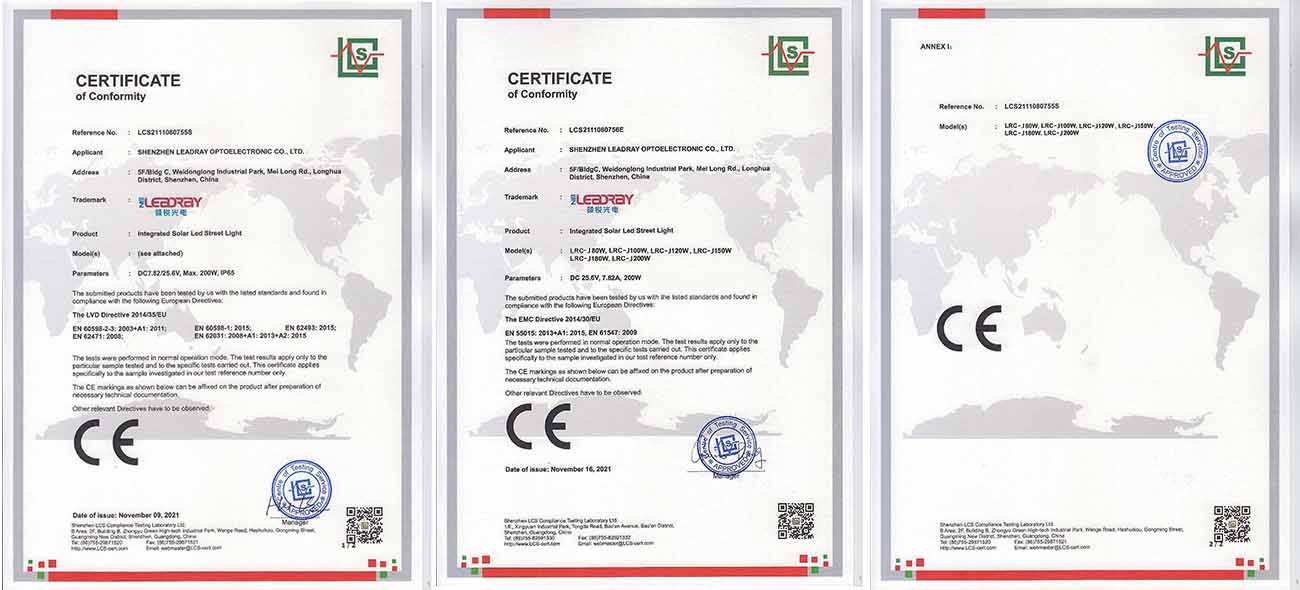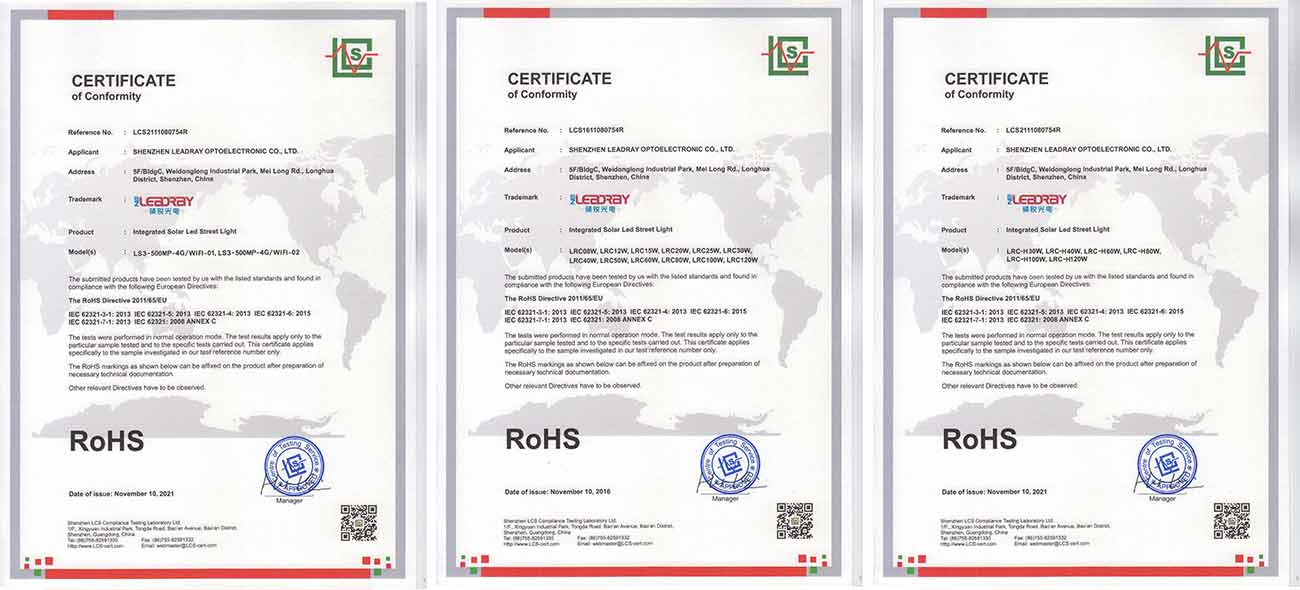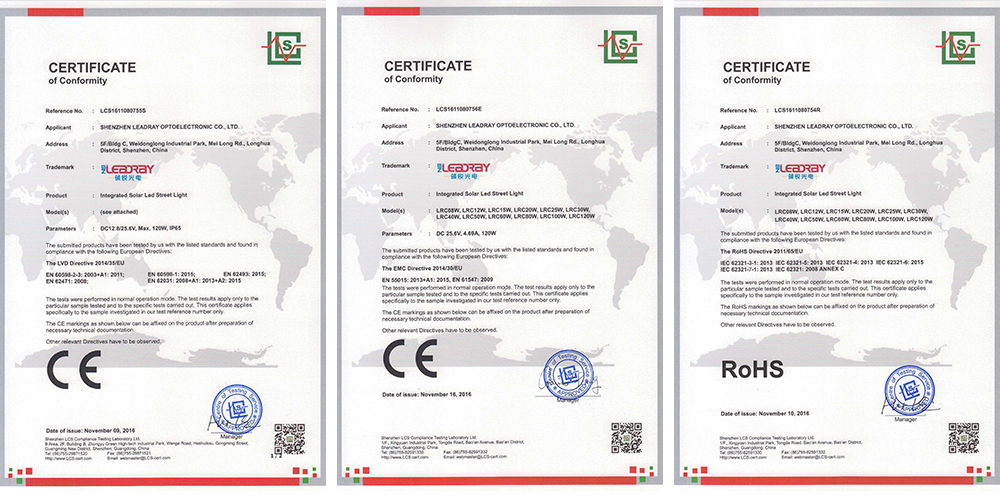For solar street light factory products to enter the EU market, CE certification and ROHS directive are two mandatory compliance requirements. The former focuses on product "safety and performance compliance", while the latter focuses on "restriction of hazardous substances".
Together, the two constitute the "entry threshold" for products to enter the EU and the European Economic Area (EEA).

CE is a comprehensive mark indicating that a product complies with EU safety, health, and environmental requirements
Compliance with three core EU directives
① Low Voltage Directive (LVD, 2014/35/EU): Regulates electrical safety, covering the power supply system (e.g., solar panels, batteries, inverters), internal wiring, and electrical insulation of solar street lights to prevent the risk of electric shock and short circuits.
② Electromagnetic Compatibility Directive (EMC, 2014/30/EU): Regulates electromagnetic interference and immunity, preventing electromagnetic signals generated by street lights from interfering with surrounding devices (e.g., communication base stations and smart home devices), while also protecting the street lights from external electromagnetic signals.
③ Energy Efficiency Directive (ErP, 2019/2020): Regulates energy efficiency and eco-design, specifying indicators such as luminous efficacy (≥80 lm/W), standby power consumption (≤0.5W), and lifespan (≥30,000 hours) for solar street lights, promoting low-carbon products.

ROHS is the CE directive on the restriction of hazardous substances in electrical and electronic products
The current EU ROHS directive is 2022/542/EU (effective in July 2023), which restricts a total of 10 hazardous substances, covering electronic components (such as PCB boards, chips, connectors), metal parts (such as bracket coatings), and plastic parts (such as casings) of solar street lights.

Achieving CE & ROHS compliance in solar street light factories requires more than just final testing; a comprehensive process control system must be established to avoid the risk of batch failures:
1. Product Development Phase: Incorporate compliance requirements early
Prioritize the use of ROHS-compliant materials (such as lead-free solder and phthalate-free plastics) during design;
Electrical design must comply with LVD/EMC standards (e.g., by adding EMC filter capacitors and optimizing grounding);
Energy efficiency parameters must be set in accordance with the ErP Directive (e.g., by using high-efficiency LEDs, ≤120 lm/W).
2. Supply Chain Control: Avoiding Hazardous Substances at the Source
Require suppliers to provide ROHS test reports for raw materials (e.g., plastic pellets, PCBs, and components);
Sign compliance agreements with core suppliers to clearly define hazardous substance limits and accountability clauses;
Conduct regular compliance audits of suppliers (e.g., verifying material procurement records and the authenticity of test reports).
3. Factory Production Stage: Process Contamination Prevention/Misuse
Production Line Zoning: Avoid cross-contamination between lead-containing and lead-free components (e.g., separate soldering stations);
Material Identification: ROHS-compliant materials are labeled "ROHS" to prevent misuse;
Process Sampling: Semi-finished products (e.g., LED modules and controllers) are sampled from each batch for rapid ROHS testing (e.g., X-ray fluorescence spectrometry).
4. Certification and Document Retention: Ensure Traceability
Select an EU-recognized third-party Notified Body for testing (some high-risk products, such as special voltage streetlights, require a Notified Body);
Retain complete documentation: test reports, Declaration of Conformity (DoC), and supply chain material certification for at least five years;
Product Labeling: Affix the CE mark (≥5mm in height, clearly legible) to the streetlight body or packaging, along with a ROHS declaration of compliance (e.g., "Compliant with 2022/542/EU").

leave a message
Scan to Wechat :

Scan to WhatsApp :
